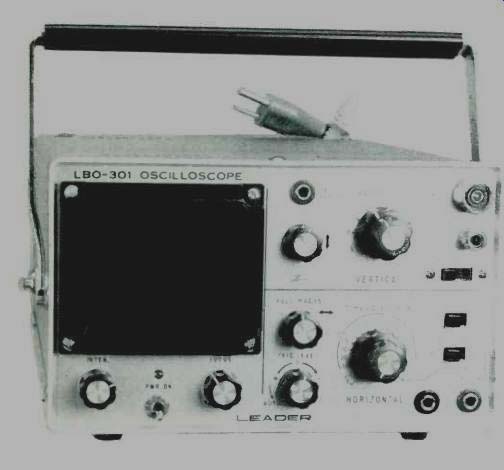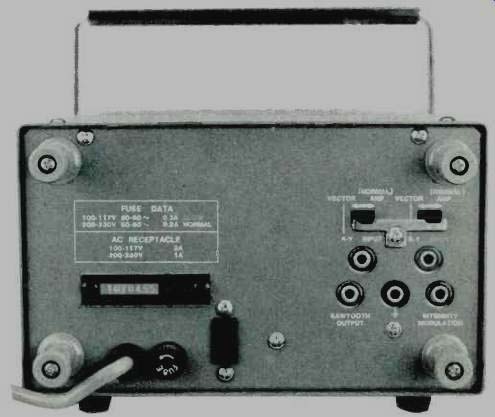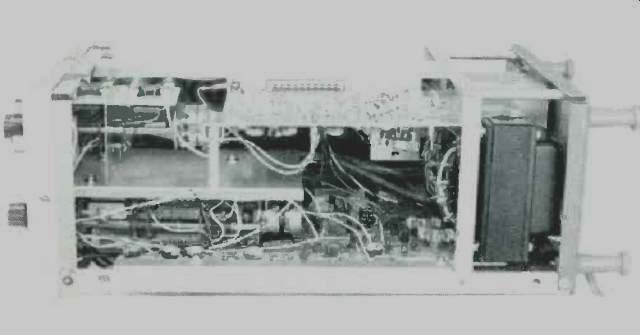
MANUFACTURER'S SPECIFICATIONS:
Vertical Sensitivity: 10 mV p-p to 5 V p-p per division, in 9 steps; uncalibrated continuous control between steps up to 10 V p-p per division.
Bandwidth: d.c. to 7 MHz.
Input Impedance: 1 Meg/40 pF direct; 10 Meg/15 pF (or less) with probe.
Horizontal Amplifier: Sweep Speed, 1µ sec to 0.2 sec/division in 17 steps; uncalibrated continuous control between steps to 0.5 sec/division; 5X magnifier at all TIME/DIV settings.
Sweep Synchronization: triggered and automatic.
Control: triggered and automatic, internal and external, + and-slope.
Sensitivity: 1 V p-p normal; 200 mV p-p at X 5 magnification.
Sweep Bandwidth: 2 Hz to 200 kHz.
Dimensions: 4 3/4" H x 8" W x 12" D.
Weight: 8.8 lbs.
Price: $389.95.
Miniaturization of practically everything in the electronics field has resulted in a whole new breed of instrumentation which does not require a truck to handle it nor does it necessarily imply any diminution in performance. One instrument which traditionally has been the largest element on a test bench is the oscilloscope-and this is likely due to the fact that the user wants as large a screen as possible, and a large screen demands a longer tube. Thus the usual dimensions of the common 5-inch 'scope were about 10 in. wide by 13 in. high by, say, 17 in. deep, and if one wanted sweep triggering it was almost impossible to get it in anything less than the 5-in. variety. That is, unless one could afford one of the professional models which could run up in price close to that of the average automobile.
The Leader LBO-301, however, provides practically every facility found in the more expensive scopes-and the larger ones, too-in a compact unit. All solid-state, of course (except for the CR tube itself), with nine steps of attenuation as well as a continuously variable control, and with triggering or automatic sweep over 17 steps, together with switch settings for both vertical and horizontal TV sweep speeds as well as for external horizontal sweeping. Input to the vertical amplifier may be either a.c. coupled or direct for d.c. measurements. Separate triggering input is also available. For users who have need to service color TV sets, there is a built-in vectorscope facility available on rear panel input jacks, together with switches to set either normal or vector operation. In addition, there is a 10-V p-p sawtooth output jack for those applications requiring it. There is also a jack providing for intensity modulation of the beam.
Mechanically, the unit is equipped with a carrying handle, and with four rubber feet for use in the usual horizontal position. On the rear are four rubber feet on standoffs which serve to store the a.c. cord when carrying, as well as to permit vertical operation.
The front panel accommodates the CR tube in the upper left corner, with its graticule marked in 8 vertical and 10 horizontal divisions of 6 mm each, with 5 minor divisions on the centerlines, and with 12 markings 30 deg. apart for vectorscope application. The remainder of the front panel is divided into three sections-the one under the CR tube accommodates the intensity and focus controls, as well as the power switch and pilot light. The upper right section has a jack which provides a 0.5-V p-p square wave of approximately 1000 Hz (the test sample was 961 Hz) for calibration purposes. Below the jack is the vertical positioning control.
Next to the right is the dual-concentric sensitivity control with 9 positions for calibrated inputs. The smaller red knob provides a variable sensitivity between steps of the switch, being out of circuit when turned fully to the right to the " CAL'D" position. At the far right are the input jacks-the "hot" input being a UHF receptacle which accommodates a standard UHF plug or the 10X probe cable. The latter, a furnished accessory, has several interchangeable tips--a sharp point, a hook, and a spring-loaded retractable hook. The cable is 6 feet in length and offers a 10 to 1 reduction in signal level, and presents a load of 10 megohms shunted by 15 pF. Also furnished are six clip-terminated leads and a UHF plug fitted with a 5-way binding post, and a grounding lead which snaps around the base of the probe. Under the UHF input jack is the ground jack, so spaced as to accept the usual 1/4-in.-spaced dual banana plugs. Below the ground jack is the input switch, with three positions--AC, DC, and GND-the latter grounding the input jack.
The lower right section is for the horizontal control. At the left are the horizontal positioning control, the knob, when pulled out, actuates the 5X magnifier-increasing the sweep magnitude by five times. Below it is the trigger level control, with a switch at the maximum counterclockwise position actuating the automatic sweep. The next large knob sets the sweep rate, with 17 positions from 0.2 sec/ div to lµ sec/div; two more positions for automatic TV vertical (approximately 60 Hz) and automatic TV horizontal (approximately 15,750 Hz). The remaining position is for external horizontal input to the sweep amplifier. The small red knob of the dual concentric control provides , for continuously variable sweep speed. At the far right are two slide switches-the upper one controls trigger slope, + or-, while the lower one selects internal or external triggering.
Two more jacks (all jacks accept banana plugs) are for external horizontal input or external trigger input and the necessary ground inputs.
The extreme compactness of this instrument makes it a joy to use, and after several months of workbench application, it has been found to provide every needed function.
For years, this observer used a conventional tube-type 5-inch scope-also a triggered type-but space and modernization dictated the use of a smaller unit, and the Leader LBO-301 serves admirably. Bandwidth was noted as reaching 7.5 MHz easily; intensity and focus controls provided an exceptionally usable display, and for all audio applications the 'scope serves well. This observer has never had occasion to use the vectorscope facility, but if it performs as perfectly as the remainder of the instrument, it would be completely satisfactory.

Fig. 1--View of rear panel showing vectorscope switches and input jacks
for the vector display, as well as the saw tooth output and intensity modulation
jacks.
No review of this type of device should be complete without complimenting the manufacturer for a complete and informative instruction book. Since the circuit employs 45 transistors (of which three are FET's) and 30 diodes (of which five are Zeners), complete circuit data is desirable. This book describes the unit completely and could serve as a short course in the applications of the 'scope in voltage measurement, frequency measurement, and the checking of diodes and transistors. The circuit is assembled on five circuit boards, with the 1500-volt CR tube anode supply being derived from a transistor oscillator and the associated transformer and rectifier/filter circuitry. Full instructions for servicing are furnished in the instruction book, together with a very complete parts list. In short, a very serviceable book.

Fig. 2--View of the right side of the 'scope with the cover removed. Note
long "feet" at right. These serve as storage for the power cable
which is simply wound around the extended feet.
In the interest of extreme compactness, two items have been omitted which we would have liked to find in the instrument-one is a source of illumination for the graticule, and the other is a d.c. input for the horizontal input. Space probably ruled against the former, and because a d.c. balance voltage is fed to the base of the input transistor in the horizontal input, the application of a direct voltage to this point would disturb the balance. However, neither of these "omissions" is of great importance, and the instrument as it stands is exceptionally convenient to use, provides everything necessary for the audio experimenter and the TV technician, and is well within the price range of the average user. This observer certainly welcomes it for its performance and its compactness. It fits easily on a typical instrument shelf above the workbench, not requiring a separate support adjacent to the bench area. On the whole a most desirable unit.
The Leader LS-5 Electronic Switch is a useful accessory for use with the 301 'scope-or with any other, for that matter. This device offers dual-trace capability to the 'scope, functions over a range from d.c. to 200 kHz, and offers a wide range of switching frequencies. Calibrated at 1.5, 5, 30, and 50 kHz, its switching frequencies actually measured 1799, 4910, 31,423, and 79,188 Hz on a frequency counter. When the maximum switching frequency of an electronic switch does not exceed 5 kHz-which was the approximate limit of the writer's previous electronic switch--the input frequencies are limited. However, with the extension of switching rates to 50 kHz at least, the displayed frequency presents a pair of practically continuous lines, which makes it much easier to comprehend.
The LS-5 is small, measuring only 3 1/8"x 5 1/2"x 4 3/8" deep, and it weighs only 2.7 lbs. A bracket attached to the case is intended to permit attachment to the bezel-mounting screw on the average 'scope, so it becomes almost a permanent part of the 'scope, since a receptacle is provided on the rear into which the 'scope can be plugged, thus saving an extra power cable.
The switch is fitted with three slide switches--one for power, and the other two for a.c. or d.c. connection to the inputs, both of which are provided with a pair of diode connected transistors for protection. The inputs are fed to the gates of two FET's, with the vertical positioning being controlled by varying the source bias on the FET's. The outputs of the two circuits are combined in an emitter follower and fed to the 'scope through the OUTPUT jack. The four-frequency multivibrator employs two transistors, with the speed being controlled by selecting capacitor pairs.
Gain controls are provided for both channels, as positioning controls, and the front panel accommodates six binding posts with banana receptacles--two inputs with a common ground on the left side and trigger and output binding posts on the right side with their common ground. A pilot light (neon) and the switching-rate selector complete the layout.
The circuit employs the aforementioned two FET's for inputs and a third FET for the trigger output. Two bipolar transistors are diode connected to serve as input protectors.
Two more serve as amplifiers which have their outputs combined to feed another as the output emitter follower; two more comprise the multivibrator, and the remaining two are regulators for the +9 and-9 volt supplies required for the circuit. The power transformer can be wired for either 100- or 115-volt a.c. mains, or for 200 or 230 volts, as required.
The unit does exactly what it is supposed to do, and is most handy in use. As with the LBO-301 'scope, the instruction book is complete in both description and operating instructions, as well as a detailed parts list, printed-circuit board layout, and schematic--everything needed to perform your own maintenance.
-C.G. McProud
(Audio magazine, May 1973)
Also see:
Nakamichi Model T-100 Audio Analyzer (Equip. Profile, Nov. 1978)
Realistic Sound Level Meter (Nov. 1978)
Heathkit IM-102 Digital Multimeter (The Workbench) (Nov. 1973)
= = = =